 |
|||||||||||||||||||||||
|
Volume 12, Issue 23 ~ June 3-9, 2004
|
|||||||||||||||||||||||
|
|
Earliest Artists Little ones bring the village to life each morning.
“They’re making friends,” says Christine Maceo who attends classes with her sons. “They love the music. They sing, dance, play drums and shakers. They’re very happy.” Anthony and James say nothing. They’re busy with a post-class snack of animal crackers and juice in the Beaux Arts Cafe. “They love the cafe too,” says mom. Nearby, Annapolitan Teresa Sweeney, going on two years old, is a veteran of Kindermusik classes. She samples cream cheese and juice for her snack. “Kindermusik exposes her to rhythm and music in a fun way. She loves the music and dance,” mom Gabriella Sweeney says.
“The two-year-olds are the most satisfying,” says Shaner. “You see how they grow and progress. When they first come into the class, they cling to their mothers. In a few weeks, they don’t need the parents anymore. Sometimes, they don’t even need me. They’ve gained the independence to want to do what they want to do.” “The four-year-olds,” Shaner adds, “are learning to skip. They’re ready to be introduced to ballet and tap. They learn three ballet positions: heels together, toes open; feet apart; and heel to toe.” Shaner finds her own contentment in this village of creativity. “I like the studio here — though it’s so echoing that tap can be quite deafening,” she says. On the other hand, she finds it “great that there’s a theater in the building. The students look to see what’s going on as they leave class.”
Just now, the only one in the darkened theater is Kirsten Striegel of Annapolis. This has been her workplace for almost three years. With stage director Alex Brady, Striegel runs the shows at Maryland Hall. Whether it’s opera, ballet, concerts, meetings or political inaugurations, the technician is responsible for lights, sound and general stage conditions. During the fall-spring season, she works as few as 40 or as many as 70 hours per week. “I learned my craft when I was a dance major at Goucher College,” says Striegel. “I like this a lot better than dance. I like the manual labor. I never sit down. There’s a sense of accomplishment after a big show. I get to do everything.” Rock concerts — like the recent Hall performance of David Byrne of Talking Heads — are the hardest for Striegel to light intelligently. “There’s lots of equipment and lots of expectations,” she says. But everything went well. The biggest incident of her tenure was the fall of the stage curtain. Luckily the dry-rotted curtain came down during the night. There was no solution but to buy a new curtain. “We should replace a few other old things,” says Striegel. “We could use more money.” Learning from His Students Upstairs in the art gallery, Mike Patton of Pasadena is taking colorful artworks off the wall. It’s the end of an exhibit by the special adult art students of Providence Center in Baltimore, where Patton is director of the Providence Art Institute.
Patton’s approach to his own sculptures and paintings has been challenged by his work with developmentally handicapped students, he admits, but it is not yet so free. “I still give too much attention to expectation,” he says. “I’d like to just do it like they do.” Patton takes down another piece. He says, “We’ve been lucky. Maryland Hall has given us space for an exhibit for the past 10 years.” Striving for Perfect Form Ballet instructor Eileen Razzetti of Annapolis has been part of this village longer still. “I started at Maryland Hall 12 years ago,” she says. “Now I have 150 students and teach 98 percent of the Academy Ballet School classes.” That’s 22 classes each week. She’s just finished with a group of four-year-olds. Later she’ll teach nines, tens, teens, adults.
Razzetti’s adult ballet classes draw high school girls with no previous ballet experience, including cheerleaders and drama students who are too old for the beginner classes. Women who danced when they were young also come. “Jazzercise doesn’t work for them because there’s no style,” says Razzetti. “They want a class where they have to strive for a specific form. Striving is part of ballet.” Organizing a Volunteer Army Louise White’s striving is of another kind. As manager of volunteers, White organizes and trains more than 100 people who work during theater performances as ushers or in the lobby. Others work as gallery attendants or give clerical help. Recently, midshipmen and Comcast volunteers came to mulch and work in the gardens of the Founders Green and in the perennial beds.
“Now they handle things with more confidence,” says White. With 850 people a full house for the theater, that’s important. This village is a comfortable home for White, too. “It’s wonderful to work here,” she says. “If you’re at the computer too long, you can come out and see some little dancer in tights running down the hallway, or hear some young musician in the Peabody studio or take a break in the gallery.” In the Pottery Studio In the pottery studio, instructor Amanda Pellerin of Baltimore works to trim a student bowl. Pellerin has been teaching her craft for 10 years, over two at Maryland Hall. “With the great natural light and high ceilings, this is a good studio space,” she says. She and fellow teacher Tina Gebhart are exploring a range of glazes with the studio’s electric kiln. Her short dream list includes an outdoor kiln for higher-temperature firing techniques. “This is a close group,” she says of her students. “One midshipman comes every session and brings different female mids each time. Women in the day classes make friends and eat lunch together.” Student Leigh Gruber of Annapolis agrees that this is the place to be. “I’ve been to three sessions. Amanda is patient with me, and I’m getting a little bit better. It’s fun. I like creating. I maxed out on jewelry classes.” Training with an Artist in Residence It’s musical creativity on the minds of teenagers Steve Szybowski of Stevensville and Zach Bussell of Bowie, who are playing guitar in resident artist Rob Levit’s studio.
As artist in resident for two years, Levit teaches and takes his music skills into community centers and schools. He’s hosted a world concert series and a gathering of creative women of Annapolis.
Szybowski, who’s been Levit’s student for the past year, finds another value here. “This place has great acoustics,” says the teen. “I like the echo, especially out in the hall.” Sustaining the Village Mary Johnson of Annapolis cleans up the hall and all the galleries, studios and restrooms, too. “It’s a good place to work,” she agrees. “There’s a lot going on, a lot of people around: dancers, musicians, artists.” Founders Day Celebration June 5-6 |
||||||||||||||||||||||
|
© COPYRIGHT 2004 by New Bay Enterprises, Inc. All rights reserved. |




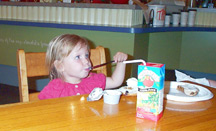
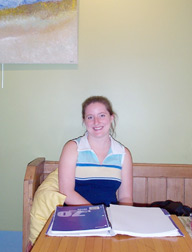
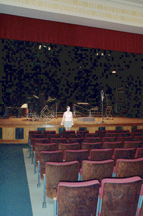
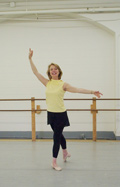
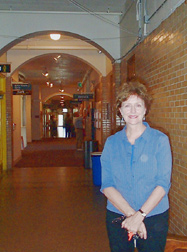
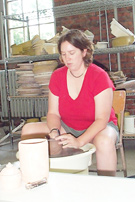
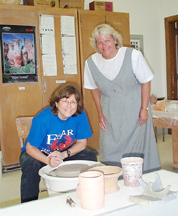
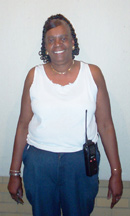
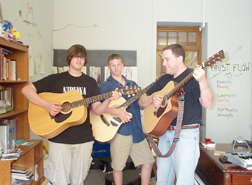
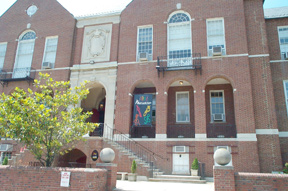 All Day
All Day